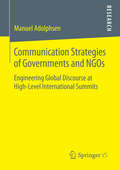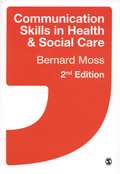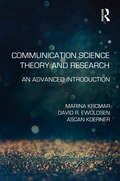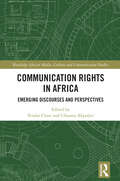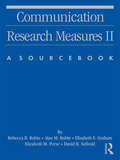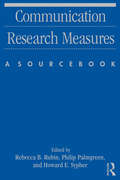- Table View
- List View
Communication Strategies of Governments and NGOs: Engineering Global Discourse at High-Level International Summits
by Manuel AdolphsenProcesses of global governance are mostly invisible to ordinary citizens, due to an overall lack of accompanying transnational public discourse. However, there are exceptional occasions on which media around the world do pay attention to global governance: high-level summits, such as the UN climate change conferences. Through a detailed case study of UN climate summits, Manuel Adolphsen investigates the transnational communication strategies and behind-the-scenes coordination processes that prominent governments and NGOs carry out on such occasions. His research reveals political actors’ conscious use of summits as public diplomacy resources as well as the prevalence of on-site coproduction routines among journalists and PR professionals. Summits feature complex public diplomacy constellations interweaving transnational, international, and also solely domestic processes.
Communication Strategies: Psycholinguistic and Sociolinguistic Perspectives (Applied Linguistics and Language Study)
by Gabriele Kasper Eric KellermanThis book examines the topic of communication strategies, the ways in which people seek to express themselves or understand what someone else is saying or writing. Typically, the term has referred to the strategies that non-native speakers use to address the linguistic and pragmatic problems encountered in interactions with native and non-native speakers of the language in question.Studies adopting a psycholinguistic perspective are well represented and updated in this volume. Other chapters re-examine communication strategies from a sociolinguistic perspective, exploring the strategies non-native speakers and their conversational partners use to create shared meanings in ongoing discourse. These studies reveal how communication strategies can serve to construct participants' identities and social relationships. Finally, the book incorporates a number of chapters which cover strategy-like behaviour in other related areas, such as language pathology, child bilingualism, normal native adult interaction, and mother tongue education. These studies add fresh dimensions to the study of communication strategies, showing how the concept can usefully be extended beyond the realm of second language acquisition and use, and pointing out the commonalities in many domains of language behaviour.
Communication Strategies: Psycholinguistic and Sociolinguistic Perspectives (Applied Linguistics and Language Study)
by Gabriele Kasper Eric KellermanThis book examines the topic of communication strategies, the ways in which people seek to express themselves or understand what someone else is saying or writing. Typically, the term has referred to the strategies that non-native speakers use to address the linguistic and pragmatic problems encountered in interactions with native and non-native speakers of the language in question.Studies adopting a psycholinguistic perspective are well represented and updated in this volume. Other chapters re-examine communication strategies from a sociolinguistic perspective, exploring the strategies non-native speakers and their conversational partners use to create shared meanings in ongoing discourse. These studies reveal how communication strategies can serve to construct participants' identities and social relationships. Finally, the book incorporates a number of chapters which cover strategy-like behaviour in other related areas, such as language pathology, child bilingualism, normal native adult interaction, and mother tongue education. These studies add fresh dimensions to the study of communication strategies, showing how the concept can usefully be extended beyond the realm of second language acquisition and use, and pointing out the commonalities in many domains of language behaviour.
Communication Skills in Health and Social Care (2nd edition) (PDF)
by Bernard MossThis thoroughly revised and updated Second Edition of Communication Skills for Health and Social Care provides an accessible introduction to the wide range of communication skills needed for contemporary health and social care practice. Presented in a unique and easy-to-use dictionary format, the book acts as a working tool which students can dip in and out of throughout their course, and continue to use once they have qualified for practice. The updated edition includes new chapters on: Groupwork. Interprofessional Collaboration. Emotional Intelligence. Assertiveness. Information and Communication Technologies (ICT). Offering a fresh approach to a core topic on the health and social care curriculum, each chapter suggests group activities and further reading, making this book an ideal resource for students of health, social care, social work and nursing, as well as qualified practitioners. Bernard Moss is Emeritus Professor of Social Work Education and Spirituality at Staffordshire University and Senior Fellow and National Teaching Fellow, Higher Education Academy, UK.
Communication Skills for Foreign and Mobile Medical Professionals
by Kris van de Poel Eddy Vanagt Ulrike Schrimpf Jessica GasiorekAround the world, the number of internationally mobile medical professionals is steadily increasing, posing potential difficulties for the good communication with patients and colleagues that is vital to satisfactory outcomes and personal professional success. Communication Skills for Foreign and Mobile Medical Professionals is an evidence-based communication resource book designed for all medical professionals who work in foreign countries, cultures, and languages. It offers a wealth of insights into doctor-patient communication, structured around the different phases of the consultation. The proposed strategies and tips will raise the reader’s awareness of important recurring issues in face-to-face interactions and improve his or her ability to deal with them effectively. Common misunderstandings between doctors and patients with a different cultural/linguistic background are discussed in depth. Throughout, the emphasis is on patient-oriented medicine. The modular structure of the book will ensure quick and easy retrieval of information. Communication Skills for Foreign and Mobile Medical Professionals will be of benefit to a wide range of medical professionals, from senior nursing staff through to heads of department, in multilingual or intercultural contexts. It will also be of value to human resource managers, language trainers, and cultural mediators.
Communication Skills For Dummies
by Elizabeth KuhnkeThe key to perfecting your communication strategy Great communication skills can make all the difference in your personal and professional life, and expert author Elizabeth Kuhnke shares with you her top tips for successful communication in any situation. Packed with advice on active listening, building rapport with people, verbal and non-verbal communication, communicating using modern technology, and lots more, Communication Skills For Dummies is a comprehensive communication resource no professional should be without! Get ahead in the workplace Use effective communication skills to secure that new job offer Convince friends and family to support you on a new venture Utilising a core of simple skills, Communication Skills For Dummies will help you shine—in no time!
Communication Skills For Dummies
by Elizabeth KuhnkeThe key to perfecting your communication strategy Great communication skills can make all the difference in your personal and professional life, and expert author Elizabeth Kuhnke shares with you her top tips for successful communication in any situation. Packed with advice on active listening, building rapport with people, verbal and non-verbal communication, communicating using modern technology, and lots more, Communication Skills For Dummies is a comprehensive communication resource no professional should be without! Get ahead in the workplace Use effective communication skills to secure that new job offer Convince friends and family to support you on a new venture Utilising a core of simple skills, Communication Skills For Dummies will help you shine—in no time!
Communication Sciences and Disorders: An Introduction to the Professions
by Dale F. WilliamsFew activities can match the complexity of human communication. Given its intricacy, it is understandable that the process will not always work properly. When it doesn't, the effects can be devastating, given how much of everyday life depends on communicating with one another. Despite its importance, however, much is still unclear about how we turn thoughts into language and then speech. Debates rage over various components of the communication system. Myths abound, most based on nothing more than speculation and misinformation. It all makes for a fascinating area of study and practice, particularly when considering the importance of the topic. This book provides readers with the basics of human communication without shying away from the controversies. Dale F. Williams, Ph.D. utilizes a panel of internationally recognized experts in all areas of the field to clearly explain normal communication as well as disorders of speech, language, hearing, and swallowing. Topics that overlap all disorders—diagnosis, treatment, research, ethics, work settings, and multicultural issues—are also covered in a reader-friendly style. In addition to the relevant information on human communication, the book also includes first-hand accounts of both people with disorders and those who work with them. Discussion questions are posed to help readers explore the gray areas and additional readings are described for those wishing to research specific topics. In these ways, readers are provided with information that truly helps them to understand communication sciences and disorders from a variety of perspectives. Communication Sciences and Disorders: An Introduction to the Professions is essential reading for anyone contemplating a career in speech-language pathology or audiology. In addition, the clear and entertaining writing style makes the field, in all its complexity, accessible to anyone with even a passing interest in the process of human communication.
Communication Sciences and Disorders: An Introduction to the Professions
by Dale F. WilliamsFew activities can match the complexity of human communication. Given its intricacy, it is understandable that the process will not always work properly. When it doesn't, the effects can be devastating, given how much of everyday life depends on communicating with one another. Despite its importance, however, much is still unclear about how we turn thoughts into language and then speech. Debates rage over various components of the communication system. Myths abound, most based on nothing more than speculation and misinformation. It all makes for a fascinating area of study and practice, particularly when considering the importance of the topic. This book provides readers with the basics of human communication without shying away from the controversies. Dale F. Williams, Ph.D. utilizes a panel of internationally recognized experts in all areas of the field to clearly explain normal communication as well as disorders of speech, language, hearing, and swallowing. Topics that overlap all disorders—diagnosis, treatment, research, ethics, work settings, and multicultural issues—are also covered in a reader-friendly style. In addition to the relevant information on human communication, the book also includes first-hand accounts of both people with disorders and those who work with them. Discussion questions are posed to help readers explore the gray areas and additional readings are described for those wishing to research specific topics. In these ways, readers are provided with information that truly helps them to understand communication sciences and disorders from a variety of perspectives. Communication Sciences and Disorders: An Introduction to the Professions is essential reading for anyone contemplating a career in speech-language pathology or audiology. In addition, the clear and entertaining writing style makes the field, in all its complexity, accessible to anyone with even a passing interest in the process of human communication.
Communication Science Theory and Research: An Advanced Introduction
by Marina Krcmar David R. Ewoldsen Ascan KoernerThis volume provides a graduate-level introduction to communication science, including theory and scholarship for masters and PhD students as well as practicing scholars. The work defines communication, reviews its history, and provides a broad look at how communication research is conducted. It also includes chapters reviewing the most frequently addressed topics in communication science. This book presents an overview of theory in general and of communication theory in particular, while offering a broad look at topics in communication that promote understanding of the key issues in communication science for students and scholars new to communication research. The book takes a predominantly "communication science" approach but also situates this approach in the broader field of communication, and addresses how communication science is related to and different from such approaches as critical and cultural studies and rhetoric. As an overview of communication science that will serve as a reference work for scholars as well as a text for the introduction to communication graduate studies course, this volume is an essential resource for understanding and conducting scholarship in the communication discipline.
Communication Science Theory and Research: An Advanced Introduction
by Marina Krcmar David R. Ewoldsen Ascan KoernerThis volume provides a graduate-level introduction to communication science, including theory and scholarship for masters and PhD students as well as practicing scholars. The work defines communication, reviews its history, and provides a broad look at how communication research is conducted. It also includes chapters reviewing the most frequently addressed topics in communication science. This book presents an overview of theory in general and of communication theory in particular, while offering a broad look at topics in communication that promote understanding of the key issues in communication science for students and scholars new to communication research. The book takes a predominantly "communication science" approach but also situates this approach in the broader field of communication, and addresses how communication science is related to and different from such approaches as critical and cultural studies and rhetoric. As an overview of communication science that will serve as a reference work for scholars as well as a text for the introduction to communication graduate studies course, this volume is an essential resource for understanding and conducting scholarship in the communication discipline.
Communication Rights in Africa: Emerging Discourses and Perspectives (Routledge African Media, Culture and Communication Studies)
by Tendai Chari Ufuoma AkpojiviThis ground-breaking volume examines enduring and emerging discourses around communication rights in Africa, arguing that they should be considered an integral component of the human rights discourse in Africa.Drawing on a broad range of case studies across the continent, the volume considers what constitutes communication rights in Africa, who should protect them, against whom, and how communication rights relate to broader human rights. While the case studies highlight the variation in communicative rights experiences between countries, they also coalesce around common tropes and practices for the implementation and expression of communication rights. Deploying a variety of innovative theoretical and methodological approaches, the chapters scrutinise different facets of communication rights in the context of both offline and digital communication realities. The contributions provide illuminating accounts on language rights, digital exclusion, digital activism, citizen journalism, media regulation and censorship, protection of intellectual property rights, politics of mobile data, and politicisation of social media.This is the first collection to consider communication in Africa using a rights-based lens. The book will appeal to researchers, academics, communication activists, and media practitioners at all levels in the fields of media studies, journalism, human rights, political science, public policy, as well as general readers who are keen to know about the status of communication rights in Africa.
Communication Rights in Africa: Emerging Discourses and Perspectives (Routledge African Media, Culture and Communication Studies)
This ground-breaking volume examines enduring and emerging discourses around communication rights in Africa, arguing that they should be considered an integral component of the human rights discourse in Africa.Drawing on a broad range of case studies across the continent, the volume considers what constitutes communication rights in Africa, who should protect them, against whom, and how communication rights relate to broader human rights. While the case studies highlight the variation in communicative rights experiences between countries, they also coalesce around common tropes and practices for the implementation and expression of communication rights. Deploying a variety of innovative theoretical and methodological approaches, the chapters scrutinise different facets of communication rights in the context of both offline and digital communication realities. The contributions provide illuminating accounts on language rights, digital exclusion, digital activism, citizen journalism, media regulation and censorship, protection of intellectual property rights, politics of mobile data, and politicisation of social media.This is the first collection to consider communication in Africa using a rights-based lens. The book will appeal to researchers, academics, communication activists, and media practitioners at all levels in the fields of media studies, journalism, human rights, political science, public policy, as well as general readers who are keen to know about the status of communication rights in Africa.
Communication Research Methods in Postmodern Culture
by Larry Z LeslieCommunication Research Methods in Postmodern Culture explores communication research from a postmodern perspective while retaining key qualitative and quantitative research methods. The author uses easy-to-understand language to incorporate new research methods inspired by contemporary culture and includes review questions and suggested activities designed to help readers understand and master communication research. The blend of new and traditional methods creates a book appropriate to the study of communication in an increasingly complex cultural environment.
Communication Research Methods in Postmodern Culture
by Larry Z LeslieCommunication Research Methods in Postmodern Culture explores communication research from a postmodern perspective while retaining key qualitative and quantitative research methods. The author uses easy-to-understand language to incorporate new research methods inspired by contemporary culture and includes review questions and suggested activities designed to help readers understand and master communication research. The blend of new and traditional methods creates a book appropriate to the study of communication in an increasingly complex cultural environment.
Communication Research Methods in Postmodern Culture: A Revisionist Approach
by Larry Z. LeslieThe second edition of Communication Research Methods in Postmodern Culture continues to explore research from a postmodern perspective. Typical qualitative and quantitative research methods are adjusted to fit the needs of contemporary culture. Each chapter is updated with new information and fresh examples. Included in the second edition is a new chapter on Internet and social media research. The author uses straightforward and easy-to-understand language. Both individual and group projects are among the suggested activities. This book is important for the study of communication in a changing political, social, economic, and technological environment.
Communication Research Methodology: A Strategic Approach to Applied Research
by Gary Pettey Cheryl Campanella Bracken Elizabeth B. PaskThis introduction to communication research methods takes the student from the conceptual beginnings of a research project through the design and analysis. Emphasizing the correct questions to ask and how to approach the answers, authors Gary Petty, Cheryl Campanella Bracken, and Elizabeth Babin approach social science methods as a language to be learned, requiring multiple sessions and reinforcement through practice. They explain the basics of conducting communication research, facilitating students’ understanding of the operation and roles of research so that they can better critique and consume the materials in their classes and in the media. The book takes an applied methods approach, introducing students to the conceptual elements of communication science and then presenting these elements in a single study throughout the text, articulating the similarities and differences of individual methods along the way. The study is presented as a communication campaign, involving multiple methodologies. The approach highlights how one method can build upon another and emphasizes the fact that, given the nature of methodology, no single study can give complete answers to our research questions. Unique features of the text: It introduces students to research methods through a conceptual approach, and the authors demonstrate that the statistics are a tool of the concepts. It employs an accessible approach and casual voice to personalize the experience for the readers, leading them through the various stages and steps. The presentation of a communication campaign demonstrates each method discussed in the text. This campaign includes goals and objectives that will accompany the chapters, demonstrates each individual methodology, and includes research questions related to the communication campaign. The tools gained herein will enable students to review, use, understand, and critique research, including the various aspects of appropriateness, sophistication and utility of research they encounter.
Communication Research Methodology: A Strategic Approach to Applied Research
by Gary Pettey Cheryl Campanella Bracken Elizabeth B. PaskThis introduction to communication research methods takes the student from the conceptual beginnings of a research project through the design and analysis. Emphasizing the correct questions to ask and how to approach the answers, authors Gary Petty, Cheryl Campanella Bracken, and Elizabeth Babin approach social science methods as a language to be learned, requiring multiple sessions and reinforcement through practice. They explain the basics of conducting communication research, facilitating students’ understanding of the operation and roles of research so that they can better critique and consume the materials in their classes and in the media. The book takes an applied methods approach, introducing students to the conceptual elements of communication science and then presenting these elements in a single study throughout the text, articulating the similarities and differences of individual methods along the way. The study is presented as a communication campaign, involving multiple methodologies. The approach highlights how one method can build upon another and emphasizes the fact that, given the nature of methodology, no single study can give complete answers to our research questions. Unique features of the text: It introduces students to research methods through a conceptual approach, and the authors demonstrate that the statistics are a tool of the concepts. It employs an accessible approach and casual voice to personalize the experience for the readers, leading them through the various stages and steps. The presentation of a communication campaign demonstrates each method discussed in the text. This campaign includes goals and objectives that will accompany the chapters, demonstrates each individual methodology, and includes research questions related to the communication campaign. The tools gained herein will enable students to review, use, understand, and critique research, including the various aspects of appropriateness, sophistication and utility of research they encounter.
Communication Research Measures III: A Sourcebook (Routledge Communication Series)
by Elizabeth E. Graham Joseph P. MazerBuilding on the measures included in the original 1994 volume and subsequent 2009 volume, Communication Research Measures III: A Sourcebook extends its coverage of measurement issues and trends across the entire communication discipline. Volume III features entirely new content and offers an assessment of new measures in mass, interpersonal, instructional, group, organizational, family, health, and intercultural communication and highlights work in emergent subdisciplines in communication, including social media and new communication technologies, sports communication, and public relations. The “best of the best” from 2009 through today, the profiled research measures in Volume III serve as models for future scale development and constitute the main tools that researchers can use for self-administered measurement of people’s attitudes, conceptions of themselves, and perceptions of others. This book is ideal for undergraduate and graduate courses that emphasize quantitative research methods, measurement, and/or survey design across communication studies disciplines.
Communication Research Measures III: A Sourcebook (Routledge Communication Series)
by Elizabeth E. Graham Joseph P. MazerBuilding on the measures included in the original 1994 volume and subsequent 2009 volume, Communication Research Measures III: A Sourcebook extends its coverage of measurement issues and trends across the entire communication discipline. Volume III features entirely new content and offers an assessment of new measures in mass, interpersonal, instructional, group, organizational, family, health, and intercultural communication and highlights work in emergent subdisciplines in communication, including social media and new communication technologies, sports communication, and public relations. The “best of the best” from 2009 through today, the profiled research measures in Volume III serve as models for future scale development and constitute the main tools that researchers can use for self-administered measurement of people’s attitudes, conceptions of themselves, and perceptions of others. This book is ideal for undergraduate and graduate courses that emphasize quantitative research methods, measurement, and/or survey design across communication studies disciplines.
Communication Research Measures II: A Sourcebook (Routledge Communication Series)
by Elizabeth Graham Rebecca B. Rubin Alan M Rubin Elizabeth M. Perse David SeiboldExpanding and building on the measures included in the original 1994 volume, Communication Research Measures II: A Sourcebook provides new measures in mass, interpersonal, instructional, and group/organizational communication areas, and highlights work in newer subdisciplines in communication, including intercultural, family, and health. It also includes measures from outside the communication discipline that have been employed in communication research. The measures profiled here are "the best of the best" from the early 1990s through today. They are models for future scale development as well as tools for the trade, and they constitute the main tools that researchers can use for self-administered measurement of people's attitudes, conceptions of themselves, and perceptions of others. The focus is on up-to-date measures and the most recent scales and indexes used to assess communication variables. Providing suggestions for measurement of concepts of interest to researchers; inspiring students to consider research directions not considered previously; and supplying models for scale developers to follow in terms of the work necessary to produce a valid and reliable measurement instrument in the discipline, the authors of this key resource have developed a significant contribution toward improving measurement and providing measures for better science.
Communication Research Measures II: A Sourcebook (Routledge Communication Series)
by Rebecca B. Rubin Alan M Rubin Elizabeth E. Graham Elizabeth M. Perse David SeiboldExpanding and building on the measures included in the original 1994 volume, Communication Research Measures II: A Sourcebook provides new measures in mass, interpersonal, instructional, and group/organizational communication areas, and highlights work in newer subdisciplines in communication, including intercultural, family, and health. It also includes measures from outside the communication discipline that have been employed in communication research. The measures profiled here are "the best of the best" from the early 1990s through today. They are models for future scale development as well as tools for the trade, and they constitute the main tools that researchers can use for self-administered measurement of people's attitudes, conceptions of themselves, and perceptions of others. The focus is on up-to-date measures and the most recent scales and indexes used to assess communication variables. Providing suggestions for measurement of concepts of interest to researchers; inspiring students to consider research directions not considered previously; and supplying models for scale developers to follow in terms of the work necessary to produce a valid and reliable measurement instrument in the discipline, the authors of this key resource have developed a significant contribution toward improving measurement and providing measures for better science.
Communication Research Measures: A Sourcebook (Routledge Communication Series)
by Rebecca B. Rubin Philip Palmgreen Howard E. SypherThe development of communication as a discipline has resulted in an explosion of scales tapping various aspects of interpersonal, mass, organizational, and instructional communication. This sourcebook brings together scales that measure a variety of important communication constructs. The scales presented are drawn from areas of interpersonal, mass, organizational, and instructional communication--areas in which the use of formal, quantitative scales is particularly well developed. Communication Research Measures reflects the recent important emphasis on developing and improving the measurement base of the communication discipline. It results in an equal amount of labor saved on the part of the scholars, students, and practitioners who find this book useful, and it contributes in a significant way to research efforts.Originally published by Guilford Press in 1994, now available from Routledge.
Communication Research Measures: A Sourcebook (Routledge Communication Series)
by Rebecca B. Rubin Philip Palmgreen Howard E. SypherThe development of communication as a discipline has resulted in an explosion of scales tapping various aspects of interpersonal, mass, organizational, and instructional communication. This sourcebook brings together scales that measure a variety of important communication constructs. The scales presented are drawn from areas of interpersonal, mass, organizational, and instructional communication--areas in which the use of formal, quantitative scales is particularly well developed. Communication Research Measures reflects the recent important emphasis on developing and improving the measurement base of the communication discipline. It results in an equal amount of labor saved on the part of the scholars, students, and practitioners who find this book useful, and it contributes in a significant way to research efforts.Originally published by Guilford Press in 1994, now available from Routledge.
Communication, Race, and Family: Exploring Communication in Black, White, and Biracial Families (Routledge Communication Series)
by Thomas J. Socha Rhunette C. DiggsThis groundbreaking volume explores how family communication influences the perennial and controversial topic of race. In assembling this collection, editors Thomas J. Socha and Rhunette C. Diggs argue that the hope for managing America's troubles with "race" lies not only with communicating about race at public meetings, in school, and in the media, but also--and more fundamentally--with families communicating constructively about race at home. African-American and European-American family communication researchers come together in this volume to investigate such topics as how Black families communicate to manage the issue of racism; how Black parent-child communication is used to manage the derogation of Black children; the role of television in family communication about race; the similarities and differences between and among communication in Black, White, and biracial couples and families; and how family communication education can contribute to a brighter future for all. With the aim of developing a clearer understanding of the role that family communication plays in society's move toward a multicultural world, this volume provides a crucial examination of how families struggle with issues of ethnic cultural diversity.
